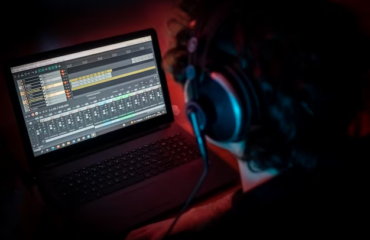Audio is gaining significant traction as a medium for content consumption, extending beyond just podcasts. Its potential as a passive and immersive experience is only just beginning to be explored. A new wave of social media apps is emerging, embracing the audio format to create a touchless world.
This trend comes at an opportune moment. After months of remote work and social isolation, video conferencing fatigue has set in. The process of joining a video call can be cumbersome, and people are seeking simpler alternatives. For those desiring user-friendly simplicity, audio-only social media apps provide an excellent solution.
Auditory Revolution: Social Audio and the Future of Content
Audio content has emerged as the epitome of accessibility, offering a fully passive consumption experience. As a society that thrives on multitasking, we can now enjoy content while driving, cooking, working out, or simply unwinding. The allure of audio lies in its intimate connection between creators and audiences, uniquely capable of conveying emotions and fostering deeper connections.
While text-based content remains prevalent, there is a noticeable shift towards supplementing engagement with audio. In the realm of social audio, particularly in live debates and engaging conversations, people can connect without the constant concern of where to direct their gaze on a screen. With platforms like Clubhouse gaining significant attention, conversations are graced by influential voices like Elon Musk, Ashton Kutcher, and Kevin Hart. The opportunity to participate in discussions alongside these celebrity idols draws massive crowds.
The rise of social audio may have been accelerated by the pandemic, but it is a medium that is here to stay. It manifests in various forms, ranging from static audio posts that resemble miniature podcasts to monetized live shows. Many platforms are even experimenting with audio interactions as a replacement for traditional text commentary. The future of content engagement is being unlocked through the power of social audio.
Changing the Social Media Landscape
The concept of audio content is not new; in fact, radio talk shows were the early predecessors of the modern-day podcast. We’ve used audio to provide news and share information, enjoy music, audiobooks, and sports. We’ve used it to learn and invest in self-development. Radio is still on the radar, but advances in technology and the introduction of smartphones have put a hot mic in the hands of anyone with an internet connection to broadcast their message to the world.
More platforms are adopting live and limited features. Live means that the content is not prerecorded but shared in real-time with an audience. Live content is great for synchronous social media interaction but also risky and less controlled. Limited features include the likes of Instagram Stories, which are short-lived pieces of content that disappear instead of living in a feed.
Social audio is taking advantage of both. Popular apps like Clubhouse focus on the here and now by catering to live conversations that disappear and cannot be accessed once the talk has ended. This is big news for the entertainment industry. One way that audio is shaping social media is by allowing performers to provide sneak-preview shows that are limited in duration. In turn, those who see the show are 67% more likely to purchase tickets to a live event.
And in the world of sports, it’s a modern take on calling into a radio show. Hosts have been covering games and giving highlights for as long as spectator sports have been around. And a new wave of social audio platforms will give this commentary a facelift. Like a traditional radio show, guests will be able to participate in the conversation by being called up on stage—so to speak. Take a look at the sports talk platform Locker Room. It’s an audio-only social media app that connects sports fans, athletes, and industry insiders in a common space. The app takes the typical play-by-play commentary and turns it into a social experience.
Reshaping Social Media: The Rise of Audio Content
The concept of audio content is not a new phenomenon; in fact, radio talk shows served as the early precursors to today’s podcasts. Throughout history, we have utilized audio to deliver news, share information, indulge in music, audiobooks, and sports. It has been a tool for learning and self-development. While radio continues to be relevant, advancements in technology and the widespread use of smartphones have empowered individuals with internet access to wield a metaphorical hot mic, allowing them to broadcast their messages to the world.
Numerous platforms are now embracing live and limited features. Live content implies that the material is shared in real-time with an audience, providing synchronous social media interaction. However, it also carries risks and offers less control. Limited features, on the other hand, encompass functionalities like Instagram Stories, which are short-lived pieces of content that vanish instead of permanently residing in a feed.
Social audio has effectively capitalized on both aspects. Prominent apps like Clubhouse cater to the present moment, focusing on live conversations that vanish once the discussion concludes. This marks a significant development for the entertainment industry. Audio has transformed social media by enabling performers to offer sneak-preview shows with a limited duration. As a result, those who witness the show are 67% more likely to purchase tickets for live events.
In the realm of sports, social audio presents a modern twist on calling into a radio show. Sports hosts have been covering games and providing highlights for as long as spectator sports have existed. However, a new wave of social audio platforms is revitalizing this type of commentary. Similar to a traditional radio show, guests can actively participate in the conversation, metaphorically being invited up on stage. An example of this is the sports talk platform Locker Room—an audio-only social media app that brings together sports fans, athletes, and industry insiders in a shared space. The app transforms the typical play-by-play commentary into a social experience.
Discover the Top Audio-Only Social Media Apps
The world of social media is evolving, and audio-based content is taking center stage. With so many apps vying for attention, it’s natural to wonder which ones are truly worth exploring. While the landscape is continually evolving, here are some of the top audio-only social media apps that have caught our attention.
- Riffr: This platform embraces the popularity of podcasting but with a twist. It offers bite-sized audio content of three minutes or less, creating a casual and spontaneous social network experience. Available for Android and iOS devices, Riffr is a free app that aims to make audio content more accessible and enjoyable;
- Audlist: If flexibility is what you seek, Audlist has got you covered. There are no limitations on the length of audio files, allowing users to share short snippets or longer discussions. While text content is limited to brief titles, the platform encourages community interactions through audio files. You can even add cover photos to enhance your posts. Audlist is available on both Android and iOS;
- HearMeOut: Dubbed as the Twitter of audio content, HearMeOut focuses on short snippets of up to 42 seconds. Every post can be accompanied by a cover image, and users can easily share their content on popular networks like Twitter, Facebook, and Instagram. With its text-based comment feature, HearMeOut offers a true social media experience. The app is available for both Android and iOS users;
- Clubhouse: Perhaps one of the most talked-about social audio apps, Clubhouse has rapidly gained popularity. From 2 million to 10 million downloads in just one month, this invitation-based app has captured the attention of millions. Initially launched on iOS and later expanding to Android, Clubhouse provides a platform for live conversations, reminiscent of TED talks and early 90s chatrooms. While it has faced criticism for its moderation practices, the app continues to attract a growing user base and pave the way for social audio genres;
- Discord: Originating from the gaming world, Discord has proven its versatility. Originally designed as a voice-to-text communication tool for gamers, it has evolved to cater to a broader audience seeking connection. With over 140 million active subscribers, Discord has become a popular choice for social interaction, particularly during the pandemic;
- Wavve: Created by audio enthusiasts for audio enthusiasts, Wavve offers a unique approach to audio content sharing. Originally targeting musicians and podcasters, Wavve enables users to combine audio files with animations and captions, resulting in engaging videos that can be shared across major platforms;
- Spoon: Similar to Clubhouse, Spoon allows users to host discussions or shows and invite audience participation. However, Spoon adds a twist by providing an in-app donation feature, enabling creators to monetize their shows;
- Checkmate: In the world of online dating, Checkmate stands out as an audio-based social platform. By restricting users to audio and video formats only, Checkmate provides a safer environment and reduces the risk of catfishing.
Advanced Strategies
With the soaring popularity of social audio, the established platforms are determined not to be left behind. Facebook is taking action by introducing fresh integrated audio features that enable users to effortlessly record and share audio content directly on the platform. Twitter has already rolled out its own offering, Twitter Spaces, which serves as audio-based chat rooms for live discussions. Additionally, Spotify has recently unveiled its own take on the trend with the introduction of the Green Room.
How Brands Can Harness the Power of Audio-Only Social Trends
The world is listening—truly paying attention! An impressive 193 million users now dedicate an average of 16 hours per week to consuming audio content. For brands, this burgeoning trend presents a remarkable opportunity to engage with audiences effortlessly and delightfully. To seize the moment, consider the following strategies to propel your social audio marketing efforts forward:
| Strategy | Description |
|---|---|
| Sponsored Advertisements | Incorporate sponsored advertisements within audio content to seamlessly integrate brand messaging into the listening experience, connecting with users in an organic and engaging way. |
| Thought Leadership Discussions | Host thought-provoking discussions in audio format to position the brand as a trusted authority. Engage industry experts, influencers, and enthusiasts to delve into relevant topics and establish the brand as a go-to resource. |
| Live Q&A Events | Organize live question-and-answer sessions to foster direct interaction with the audience. Address inquiries, share insights, and build rapport with listeners in real-time, fostering stronger connections and brand loyalty. |
| Inspirational Behind-the-Scenes Audio Blurbs | Offer exclusive behind-the-scenes glimpses into the brand’s world through short, captivating audio snippets. Provide insight into the creative process, product development, or the stories behind the brand’s success. |
| Mini Interviews with the CEO or Front-line Employees | Humanize the brand by featuring brief interviews with key figures within the organization, such as the CEO or front-line employees. Connect listeners with the people behind the brand, fostering authenticity and building trust. |
Conclusion
The surging popularity of social audio apps like Clubhouse is merely the beginning, as audio-only social media trends are poised to expand even further. Embracing the concept of “what’s-old-is-new,” open conversations are experiencing a revival. We anticipate the continuous growth of audio-focused platforms, with numerous new iterations emerging in the near future. This shift towards audio will encompass individuals, creators, brands, and entertainers, making it a ubiquitous medium for all.








